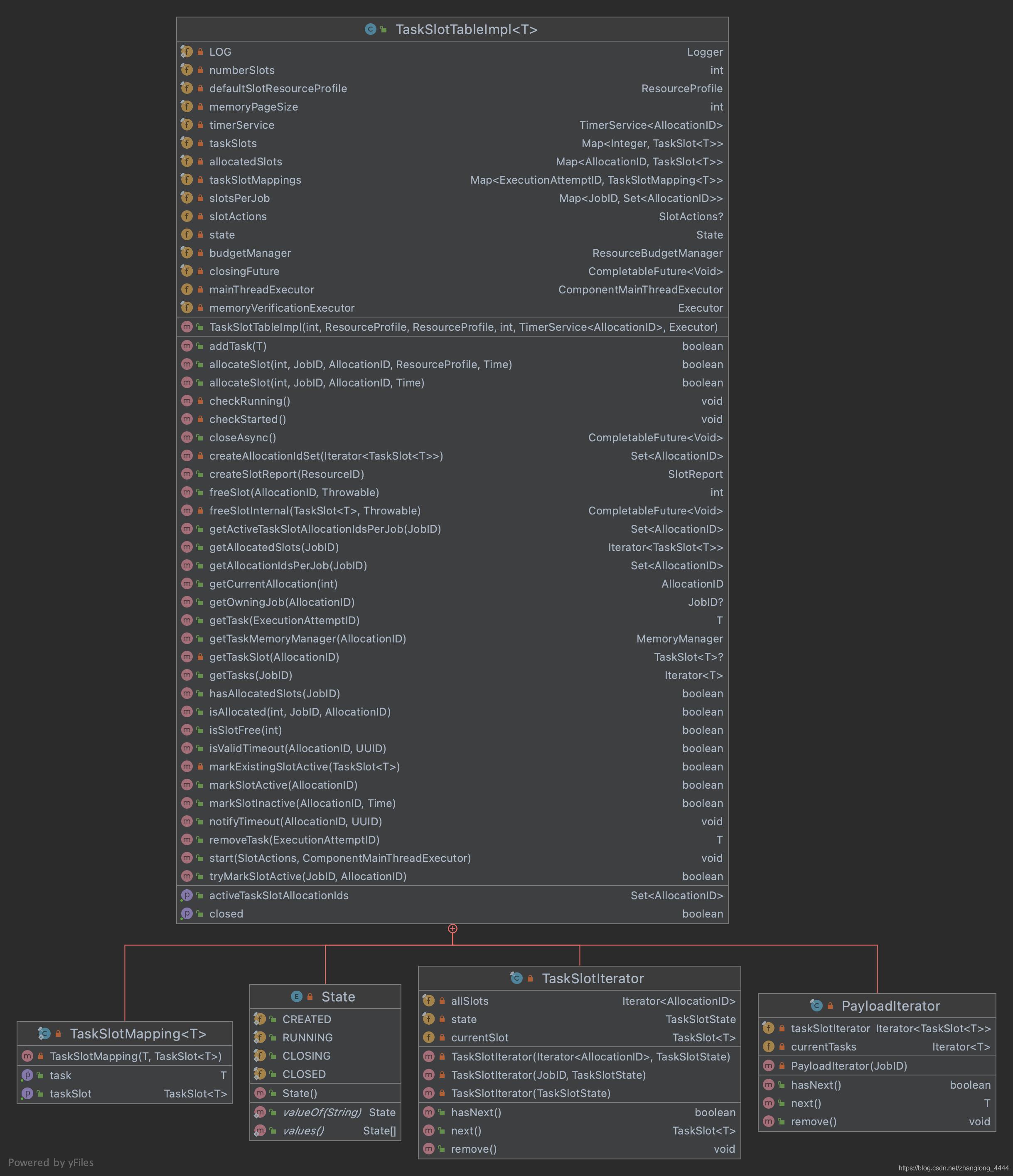FlinkFlink 1.12.2 TaskSlotTable
Posted 九师兄
tags:
篇首语:本文由小常识网(cha138.com)小编为大家整理,主要介绍了FlinkFlink 1.12.2 TaskSlotTable相关的知识,希望对你有一定的参考价值。

1.概述
转载:Flink 1.12.2 源码浅析 : TaskSlotTable
多个{@link TaskSlot}实例的容器。
此外,它还维护多个索引,以便更快地访问任务和分配的slots。
当slots无法分配给job manager时会自动超时…
在使用 TaskSlotTable 之前,必须通过 {@link #start} 方法启动它。
二 .TaskSlotTable 接口

| 名称 | 描述 |
|---|---|
| start | 根据给定的 slot actions 启动 task slot table |
| getAllocationIdsPerJob | 返回job所有的AllocationID |
| getActiveTaskSlotAllocationIds | 返回TaskSlotTable中 所有active task的 AllocationID |
| getActiveTaskSlotAllocationIdsPerJob | 返回 jobId 中 acitve TaskSlot 中所有的 AllocationID |
| createSlotReport | 返回 SlotReport |
| allocateSlot | 为给定job 和allocation id 分配具有给定索引的slot。 如果给定负指数,则生成一个新的自增指数。 如果可以分配slot,则返回true。否则返回false。 |
| markSlotActive | 将给定分配id下的slot标记为活动。 |
| markSlotInactive | 将给定分配id下的slot标记为非活动。 |
| freeSlot | 试着释放这个slot。 如果slot为空,它将任务slot的状态设置为free并返回其索引 如果slot不是空的,那么它会将任务slot的状态设置为releasing,fail all tasks并返回-1。 |
| isValidTimeout | 根据allocation id. 检查ticket 是否超时 |
| isAllocated | 根据给定的 index , job和 allocation id .检车slot状态是否为 ALLOCATED |
| tryMarkSlotActive | 根据JobID 和 AllocationID 标记匹配的slot状态为ACTIVE(如果该slot的状态为allocated) |
| isSlotFree | 检测 slot状态是否为free |
| hasAllocatedSlots | 检查作业是否已分配(非活动)slot。 |
| getAllocatedSlots | 根据job id 返回 所有的TaskSlot |
| getOwningJob | 根据AllocationID 返回所属的 JobID |
| addTask | 将给定任务添加到由任务的 allocation id 标识的slot中。 |
| removeTask | 从task slot中删除具有给定执行attempt id 的任务。 如果拥有的task slot处于释放状态并且在删除任务后为空,则通过slot actions 释放slot。 |
| getTask | 根据ExecutionAttemptID / JobID 获取task |
| getCurrentAllocation | 根据index获取改slot所分配的AllocationID |
| getTaskMemoryManager | 根据AllocationID 获取 MemoryManager |
三 .TaskSlotTableImpl
TaskSlotTableImpl 是 TaskSlotTable 接口的实现类. 负责TaskExecutor端的slot管理.

# 构造调用顺序:
org.apache.flink.yarn.YarnTaskExecutorRunner#main
org.apache.flink.runtime.taskexecutor.TaskManagerRunner#runTaskManagerProcessSecurely
org.apache.flink.runtime.taskexecutor.TaskManagerRunner#runTaskManager
org.apache.flink.runtime.taskexecutor.TaskManagerRunner#startTaskManager (返回TaskExecutor对象实例)
org.apache.flink.runtime.taskexecutor.TaskManagerServices#fromConfiguration
3.1. 属性相关
3.1.1. slot 相关
/**
* 静态slot分配中的slot数。
* 如果请求带索引的slot,则所请求的索引必须在[0,numberSlots)范围内。
* 生成slot report时,即使该slot不存在,我们也应始终生成索引为[0,numberSlots)的广告位。
*
* Number of slots in static slot allocation.
* If slot is requested with an index, the requested index must within the range of [0, numberSlots).
*
* When generating slot report, we should always generate slots with index in [0, numberSlots) even the slot does not exist.
*/
private final int numberSlots;
/**
* 缓存 index -> TaskSlot
* The list of all task slots. */
private final Map<Integer, TaskSlot<T>> taskSlots;
/**
* 缓存 AllocationID -> TaskSlot
* Mapping from allocation id to task slot.
* */
private final Map<AllocationID, TaskSlot<T>> allocatedSlots;
/**
* ExecutionAttemptID -> TaskSlotMapping
* Mapping from execution attempt id to task and task slot.
* */
private final Map<ExecutionAttemptID, TaskSlotMapping<T>> taskSlotMappings;
/**
*
*
* Mapping from job id to allocated slots for a job.
* */
private final Map<JobID, Set<AllocationID>> slotsPerJob;
/** Interface for slot actions, such as freeing them or timing them out. */
@Nullable private SlotActions slotActions;
/**
* 状态相关 : CREATED,
* RUNNING,
* CLOSING,
* CLOSED
* The table state. */
private volatile State state;
3.1.2. 其他属性
/**
* 用于静态slot分配的slot资源配置文件。
* Slot resource profile for static slot allocation.
* */
private final ResourceProfile defaultSlotResourceProfile;
/** Page size for memory manager. */
private final int memoryPageSize;
/** Timer service used to time out allocated slots. */
private final TimerService<AllocationID> timerService;
private final ResourceBudgetManager budgetManager;
/** The closing future is completed when all slot are freed and state is closed. */
private final CompletableFuture<Void> closingFuture;
/** {@link ComponentMainThreadExecutor} to schedule internal calls to the main thread. */
private ComponentMainThreadExecutor mainThreadExecutor =
new DummyComponentMainThreadExecutor(
"TaskSlotTableImpl is not initialized with proper main thread executor, "
+ "call to TaskSlotTableImpl#start is required");
/** {@link Executor} for background actions, e.g. verify all managed memory released. */
private final Executor memoryVerificationExecutor;
3.1.3. 构造方法
public TaskSlotTableImpl(
final int numberSlots,
final ResourceProfile totalAvailableResourceProfile,
final ResourceProfile defaultSlotResourceProfile,
final int memoryPageSize,
final TimerService<AllocationID> timerService,
final Executor memoryVerificationExecutor) {
Preconditions.checkArgument(
0 < numberSlots, "The number of task slots must be greater than 0.");
this.numberSlots = numberSlots;
this.defaultSlotResourceProfile = Preconditions.checkNotNull(defaultSlotResourceProfile);
this.memoryPageSize = memoryPageSize;
this.taskSlots = new HashMap<>(numberSlots);
this.timerService = Preconditions.checkNotNull(timerService);
budgetManager =
new ResourceBudgetManager(
Preconditions.checkNotNull(totalAvailableResourceProfile));
allocatedSlots = new HashMap<>(numberSlots);
taskSlotMappings = new HashMap<>(4 * numberSlots);
slotsPerJob = new HashMap<>(4);
slotActions = null;
state = State.CREATED;
closingFuture = new CompletableFuture<>();
this.memoryVerificationExecutor = memoryVerificationExecutor;
}
3.2. 方法相关
3.2.1. start
@Override
public void start(
SlotActions initialSlotActions, ComponentMainThreadExecutor mainThreadExecutor) {
Preconditions.checkState(
state == State.CREATED,
"The %s has to be just created before starting",
TaskSlotTableImpl.class.getSimpleName());
this.slotActions = Preconditions.checkNotNull(initialSlotActions);
this.mainThreadExecutor = Preconditions.checkNotNull(mainThreadExecutor);
timerService.start(this);
// 修改状态为 RUNNING
state = State.RUNNING;
}
3.2.2. closeAsync
@Override
public CompletableFuture<Void> closeAsync() {
if (state == State.CREATED) {
state = State.CLOSED;
closingFuture.complete(null);
} else if (state == State.RUNNING) {
state = State.CLOSING;
final FlinkException cause = new FlinkException("Closing task slot table");
CompletableFuture<Void> cleanupFuture =
FutureUtils.waitForAll(
// 释放slot
new ArrayList<>(allocatedSlots.values())
.stream()
.map(slot -> freeSlotInternal(slot, cause))
.collect(Collectors.toList()))
.thenRunAsync(
() -> {
state = State.CLOSED;
timerService.stop();
},
mainThreadExecutor);
FutureUtils.forward(cleanupFuture, closingFuture);
}
return closingFuture;
}
3.2.3. createSlotReport
@Override
public SlotReport createSlotReport(ResourceID resourceId) {
List<SlotStatus> slotStatuses = new ArrayList<>();
// 循环每一个slot
for (int i = 0; i < numberSlots; i++) {
// 构建SlotID
SlotID slotId = new SlotID(resourceId, i);
SlotStatus slotStatus;
if (taskSlots.containsKey(i)) {
//该slot已经分配
TaskSlot<T> taskSlot = taskSlots.get(i);
// 构建 SlotStatus
slotStatus =
new SlotStatus(
slotId,
taskSlot.getResourceProfile(),
taskSlot.getJobId(),
taskSlot.getAllocationId());
} else {
//该slot尚未分配
slotStatus = new SlotStatus(slotId, defaultSlotResourceProfile, null, null);
}
slotStatuses.add(slotStatus);
}
// 循环所有的 allocatedSlots 处理 异常的slot ???
for (TaskSlot<T> taskSlot : allocatedSlots.values()) {
// 处理 异常的slot ???
if (taskSlot.getIndex() < 0) {
SlotID slotID = SlotID.generateDynamicSlotID(resourceId);
SlotStatus slotStatus =
new SlotStatus(
slotID,
taskSlot.getResourceProfile(),
taskSlot.getJobId(),
taskSlot.getAllocationId());
slotStatuses.add(slotStatus);
}
}
// 构建SlotReport
final SlotReport slotReport = new SlotReport(slotStatuses);
return slotReport;
}
3.2.4. allocateSlot
@Override
public boolean allocateSlot(
int index,
JobID jobId,
AllocationID allocationId,
ResourceProfile resourceProfile,
Time slotTimeout) {
checkRunning();
Preconditions.checkArgument(index < numberSlots);
// 获取TaskSlot
TaskSlot<T> taskSlot = allocatedSlots.get(allocationId);
if (taskSlot != null) {
LOG.info("Allocation ID {} is already allocated in {}.", allocationId, taskSlot);
return false;
}
// 如果taskSlots 已经包含index
if (taskSlots.containsKey(index)) {
TaskSlot<T> duplicatedTaskSlot = taskSlots.get(index);
LOG.info(
"Slot with index {} already exist, with resource profile {}, job id {} and allocation id {}.",
index,
duplicatedTaskSlot.getResourceProfile(),
duplicatedTaskSlot.getJobId(),
duplicatedTaskSlot.getAllocationId());
return duplicatedTaskSlot.getJobId().equals(jobId)
&& duplicatedTaskSlot.getAllocationId().equals(allocationId);
} else if (allocatedSlots.containsKey(allocationId)) {
return true;
}
// 获取 resourceProfile
// resourceProfile = {ResourceProfile@6124} "ResourceProfile{cpuCores=1.0000000000000000, taskHeapMemory=96.000mb (100663293 bytes), taskOffHeapMemory=0 bytes, managedMemory=128.000mb (134217730 bytes), networkMemory=32.000mb (33554432 bytes)}"
// cpuCores = {CPUResource@6139} "Resource(CPU: 1.0000000000000000)"
// taskHeapMemory = {MemorySize@6140} "100663293 bytes"
// taskOffHeapMemory = {MemorySize@6141} "0 bytes"
// managedMemory = {MemorySize@6142} "134217730 bytes"
// networkMemory = {MemorySize@6143} "32 mb"
// extendedResources = {HashMap@6144} size = 0
resourceProfile = index >= 0 ? defaultSlotResourceProfile : resourceProfile;
// 存储resourceProfile
if (!budgetManager.reserve(resourceProfile)) {
LOG.info(
"Cannot allocate the requested resources. Trying to allocate {}, "
+ "while the currently remaining available resources are {}, total is {}.",
resourceProfile,
budgetManager.getAvailableBudget(),
budgetManager.getTotalBudget());
return false;
}
// 构建 taskSlot
// taskSlot = {TaskSlot@6191} "TaskSlot(index:0, state:ALLOCATED, resource profile: ResourceProfile{cpuCores=1.0000000000000000, taskHeapMemory=96.000mb (100663293 bytes), taskOffHeapMemory=0 bytes, managedMemory=128.000mb (134217730 bytes), networkMemory=32.000mb (33554432 bytes)}, allocationId: a9ce7abc6f1d6f264dbdce5564efcb76, jobId: 05fdf1bc744b274be1525c918c1ad378)"
// index = 0
// resourceProfile = {ResourceProfile@6124} "ResourceProfile{cpuCores=1.0000000000000000, taskHeapMemory=96.000mb (100663293 bytes), taskOffHeapMemory=0 bytes, managedMemory=128.000mb (134217730 bytes), networkMemory=32.000mb (33554432 bytes)}"
// tasks = {HashMap@6197} size = 0
// memoryManager = {MemoryManager@6198}
// state = {TaskSlotState@6199} "ALLOCATED"
// jobId = {JobID@6056} "05fdf1bc744b274be1525c918c1ad378"
// allocationId = {AllocationID@6057} "a9ce7abc6f1d6f264dbdce5564efcb76"
// closingFuture = {CompletableFuture@6200} "java.util.concurrent.CompletableFuture@670d0482[Not completed]"
// asyncExecutor = {ThreadPoolExecutor@6076} "java.util.concurrent.ThreadPoolExecutor@da5c1a9[Running, pool size = 0, active threads = 0, queued tasks = 0, completed tasks = 0]"
taskSlot =
new TaskSlot<>(
index,
resourceProfile,
memoryPageSize,
jobId,
allocationId,
memoryVerificationExecutor);
if (index >= 0) {
// 加入缓存...
taskSlots.put(index, taskSlot);
}
// 更新 allocatedSlots
// update the allocation id to task slot map
allocatedSlots.put(allocationId, taskSlot);
// 注册超时时间
// register a timeout for this slot since it's in state allocated
timerService.registerTimeout(allocationId, slotTimeout.getSize(), slotTimeout.getUnit());
// 更新 slotsPerJob 的slot 集合
// add this slot to the set of job slots
Set<AllocationID> slots = slotsPerJob.get(jobId);
if (slots == null) {
slots = new HashSet<>(4);
slotsPerJob.put(jobId, slots);
}
slots.add(allocationId);
return true;
}
3.2.5. freeSlot -> freeSlotInternal
清理掉各种缓存然后调用task的shutdown方法关闭任务.
private CompletableFuture<Void> freeSlotInternal(TaskSlot<T> taskSlot, Throwable cause) {
AllocationID allocationId = taskSlot.getAllocationId();
if (LOG.isDebugEnabled()) {
LOG.debug("Free slot {}.", taskSlot, cause);
} else {
LOG.info("Free slot {}.", taskSlot);
}
if (taskSlot.isEmpty()) {
// remove the allocation id to task slot mapping
allocatedSlots.remove(allocationId);
// unregister a potential timeout
timerService.unregisterTimeout(allocationId);
JobID jobId = taskSlot.getJobId();
Set<AllocationID> slots = slotsPerJob.get(jobId);
if (slots == null) {
throw new IllegalStateException(
"There are no more slots allocated for the job "
+ jobId
+ ". This indicates a programming bug.");
}
slots.remove(allocationId);
if (slots.isEmpty()) {
slotsPerJob.remove(jobId);
}
taskSlots.remove(taskSlot.getIndex());
budgetManager.release(taskSlot.getResourceProfile());
}
return taskSlot.closeAsync(cause);
}
3.2.6. 任务相关(add/remove/getTask)
@Override
public boolean addTask(T task) throws SlotNotFoundException, SlotNotActiveException {
checkRunning();
Preconditions.checkNotNull(task);
TaskSlot<T> taskSlot = getTaskSlot(task.getAllocationId());
if (taskSlot != null) {
if (taskSlot.isActive(task.getJobID(), task.getAllocationId())) {
// 根据任务的 task.getExecutionId(以上是关于FlinkFlink 1.12.2 TaskSlotTable的主要内容,如果未能解决你的问题,请参考以下文章